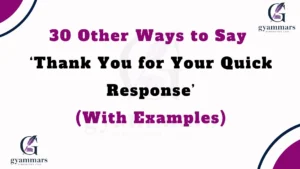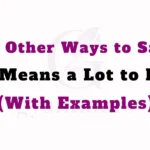Choosing the right words to express yourself can make a world of difference in how your message is received. Whether you’re working with colleagues, customers, or friends, using thoughtful language shows you care.
In this article, we’ll explore 30 alternatives to the phrase “point of contact” that can add warmth, clarity, and professionalism to your communication. These alternatives can help make your messages feel more personal, welcoming, and engaging, while still being effective and clear.
What Does “Point of Contact” Mean?
Before we dive into the alternatives, let’s start by defining the phrase “point of contact”. This term is commonly used to describe a person or position that serves as the main contact for communication within a business or situation. It’s the person you reach out to for specific needs or questions, whether it’s in a company, a customer service scenario, or a team setting. It’s all about establishing a clear communication link.
Is It Professional/Polite to Say “Point of Contact”?
While “point of contact” is widely accepted in both professional and personal settings, some might find it a bit too formal or impersonal, depending on the context. It can be very efficient for clarity, but if you want to express more warmth or empathy, using alternatives might be a better choice.
Pros or Cons of Saying “Point of Contact”
Pros:
- Clear and direct
- Commonly understood in professional settings
- Avoids confusion when referring to the person responsible for communication
Cons:
- Can feel cold or impersonal
- May sound too corporate in more casual environments
- May not convey personal connection as well as alternatives
List of 30 Alternatives:
- Primary Contact
- Main Contact
- Go-To Person
- Contact Person
- Communication Lead
- Responsible Party
- Support Contact
- Information Source
- Liaison
- Help Desk Representative
- Resource Person
- Go-To Contact
- Direct Contact
- Client Representative
- Point of Contact Person
- Contact Liaison
- Service Representative
- Project Coordinator
- Communication Manager
- Help Person
- Assistance Contact
- Request Handler
- Query Contact
- Outreach Person
- Communication Point
- Handling Representative
- Support Lead
- Information Officer
- Client Liaison
- Response Contact
1. Primary Contact
Definition: The main person or channel you should reach out to for communication.
Explanation: A primary contact indicates that this person is your go-to for all related matters. It’s often used in both personal and professional contexts.
Scenario Example:
“For any inquiries about the project, please reach out to Sarah as your primary contact.”
Best Use: When you want to emphasize that someone is the main person to communicate with for an issue.
Tone: Neutral, professional
Additional Notes: Often used in professional or service settings. Can sometimes sound a bit formal.
2. Main Contact
Definition: Refers to the central individual for communication on a particular subject.
Explanation: Similar to primary contact, but can feel slightly less formal.
Scenario Example:
“If you have any questions, Jake is your main contact for the event.”
Best Use: When you want a slightly more approachable tone than “primary contact.”
Tone: Friendly, neutral
Additional Notes: Suitable for both formal and informal settings.
3. Go-To Person
Definition: The person you rely on for information or help.
Explanation: This alternative adds a more personal touch, implying that this person is someone you trust and can depend on.
Scenario Example:
“She’s the go-to person for any updates on the meeting.”
Best Use: When you want to show trust and dependability.
Tone: Warm, conversational
Additional Notes: Great for informal and friendly environments, though still professional enough for workplace contexts.
4. Contact Person
Definition: The person you should reach out to for assistance or communication.
Explanation: A straightforward alternative that’s a bit more neutral than “point of contact.”
Scenario Example:
“Please reach out to John, our contact person for customer service.”
Best Use: When clarity is important but a formal tone isn’t required.
Tone: Neutral
Additional Notes: Common in business or customer service settings.
5. Communication Lead
Definition: A person responsible for overseeing and coordinating communication efforts.
Explanation: This alternative suggests someone who not only handles communications but is also in charge of the flow of information.
Scenario Example:
“Mary is the communication lead for this project, so please contact her with any questions.”
Best Use: When you want to highlight someone in a more managerial or leadership position.
Tone: Professional, authoritative
Additional Notes: Ideal for team or project-based environments.
6. Responsible Party
Definition: The individual in charge of a task or responsibility.
Explanation: This alternative focuses on the role of the individual in ensuring tasks are completed.
Scenario Example:
“Tom is the responsible party for processing all order requests.”
Best Use: When you need to indicate that someone is specifically accountable for an area.
Tone: Formal, direct
Additional Notes: Often used in contracts or formal documents.
7. Support Contact
Definition: A person designated to provide assistance and resolve queries.
Explanation: This alternative emphasizes the supportive aspect of the role, making it perfect for customer service contexts.
Scenario Example:
“For technical issues, reach out to Sarah as your support contact.”
Best Use: Ideal in customer service, tech support, or any help-related context.
Tone: Friendly, helpful
Additional Notes: This is a great choice for showing a customer-first mindset.
8. Information Source
Definition: The person who provides key details or insights.
Explanation: This suggests that the individual is the go-to for valuable information.
Scenario Example:
“If you need any updates, Mark is the information source for this matter.”
Best Use: When you need to highlight someone’s role in providing information.
Tone: Neutral, informative
Additional Notes: Good for situations where factual accuracy is important.
9. Liaison
Definition: A person who acts as a link between two parties.
Explanation: A liaison typically facilitates communication and ensures both parties are informed.
Scenario Example:
“If you’re unsure about any details, Jane will be your liaison between departments.”
Best Use: When you need to express that the person is bridging two areas or groups.
Tone: Professional, diplomatic
Additional Notes: Often used in corporate settings or team-based work environments.
10. Help Desk Representative
Definition: The individual you contact for troubleshooting or problem-solving.
Explanation: This one is more specific to technical or service inquiries.
Scenario Example:
“For any tech issues, please contact our help desk representative.”
Best Use: When referring to customer service or IT support.
Tone: Supportive, professional
Additional Notes: Common in IT and customer service industries.
11. Resource Person
Definition: The person you turn to for guidance or expertise.
Explanation: This term is more informal and highlights someone’s expertise or availability to help.
Scenario Example:
“Whenever you need advice on marketing, Sarah is the resource person.”
Best Use: When emphasizing someone’s expertise and willingness to help.
Tone: Friendly, approachable
Additional Notes: Suitable for less formal work environments.
12. Go-To Contact
Definition: The individual you contact when you need assistance or information.
Explanation: This emphasizes dependability and makes the person feel reliable.
Scenario Example:
“John is your go-to contact for sales inquiries.”
Best Use: When expressing that the person is the first choice for help.
Tone: Friendly, reliable
Additional Notes: More informal but still professional.
13. Direct Contact
Definition: The person you reach out to directly for specific needs.
Explanation: This alternative emphasizes the directness of communication with the person.
Scenario Example:
“For billing questions, please contact Kelly as your direct contact.”
Best Use: When you want to indicate the person to directly contact.
Tone: Neutral, straightforward
Additional Notes: Often used in formal or customer service contexts.
14. Client Representative
Definition: A person who represents the client or customer in communication.
Explanation: This alternative works well when referring to someone who speaks on behalf of the client.
Scenario Example:
“If you have any issues, John is the client representative for this project.”
Best Use: When you want to highlight someone as the client’s advocate.
Tone: Professional, formal
Additional Notes: Useful in B2B or client service industries.
15. Point of Contact Person
Definition: A specific person who serves as the main communicator for a given subject or area.
Explanation: This is just a more expanded version of “point of contact” and offers more clarity.
Scenario Example:
“For all questions regarding the event, Mary is the point of contact person.”
Best Use: When you want to be explicit about who to contact.
Tone: Neutral, formal
Additional Notes: Useful for more detailed communications where you want to be very specific.
16. Contact Liaison
Definition: A person who manages and facilitates communication between two or more parties.
Explanation: A contact liaison emphasizes the coordinating role of an individual, highlighting their responsibility for ensuring effective communication across multiple parties.
Scenario Example:
“For any concerns about the partnership, Susan is the contact liaison between both teams.”
Best Use: When you need to express that someone is bridging communication between multiple groups.
Tone: Professional, formal
Additional Notes: Useful in business or organizational contexts where multiple stakeholders are involved.
17. Service Representative
Definition: A person who assists and serves as the main point for service-related inquiries.
Explanation: The term service representative is typically used in customer service or service industries to indicate someone who can assist with various needs or issues.
Scenario Example:
“If you need assistance with your account, please reach out to our service representative.”
Best Use: When referring to someone in a customer service or client support role.
Tone: Helpful, professional
Additional Notes: This is more specific to roles in service industries.
18. Project Coordinator
Definition: A person responsible for managing and coordinating a project, including communication between all involved parties.
Explanation: A project coordinator manages timelines, tasks, and communication, ensuring everything runs smoothly.
Scenario Example:
“Jane is the project coordinator for this initiative, so she’ll be able to answer any questions you have.”
Best Use: When referring to someone handling a specific project and coordinating communications among team members.
Tone: Professional, organizational
Additional Notes: Common in project-based environments like marketing or IT teams.
19. Communication Manager
Definition: The person overseeing all communications within an organization or project.
Explanation: A communication manager not only serves as the point of contact but is responsible for shaping the overall communication strategy.
Scenario Example:
“Please contact Andrew, the communication manager, for all media-related inquiries.”
Best Use: When referring to someone in charge of communication for a business or organization.
Tone: Authoritative, formal
Additional Notes: Often used in marketing or PR departments.
20. Help Person
Definition: The individual you approach for help or guidance on a particular issue.
Explanation: This alternative is casual, adding a personal touch to the role of someone who is there to assist you.
Scenario Example:
“If you run into any trouble with the event setup, the help person will be at the entrance.”
Best Use: When you want to keep things casual and approachable.
Tone: Friendly, informal
Additional Notes: Ideal for small events, informal gatherings, or situations where the tone is less formal.
21. Assistance Contact
Definition: The person you can reach out to for assistance or support in a given context.
Explanation: An assistance contact emphasizes someone who is there to provide help or support.
Scenario Example:
“For any questions about your subscription, please reach out to our assistance contact.”
Best Use: When you want to highlight that someone is available for help or support.
Tone: Helpful, neutral
Additional Notes: This is an effective phrase in customer service or helpdesk environments.
22. Request Handler
Definition: The person who manages, processes, or responds to requests.
Explanation: A request handler is responsible for dealing with requests efficiently and ensuring they are addressed in a timely manner.
Scenario Example:
“If you have any requests regarding your order, Sarah is the request handler.”
Best Use: When you want to emphasize the role of processing or handling requests.
Tone: Direct, professional
Additional Notes: Suitable in formal business settings or where requests are processed in large volumes.
23. Query Contact
Definition: The person you contact for clarifications, queries, or questions.
Explanation: A query contact is specifically responsible for handling questions or inquiries.
Scenario Example:
“For any queries regarding our terms and conditions, please contact our query contact.”
Best Use: When you want to refer to someone who handles questions or concerns.
Tone: Neutral, professional
Additional Notes: Commonly used in customer service, technical support, or HR-related contexts.
24. Outreach Person
Definition: The person responsible for initiating contact and building relationships with others.
Explanation: The term outreach person focuses on someone who takes the initiative to reach out and engage with others for communication or support.
Scenario Example:
“If you’re looking to collaborate, reach out to Linda, the outreach person for our team.”
Best Use: When referring to someone tasked with building connections or relationships.
Tone: Friendly, proactive
Additional Notes: This is a collaborative term and is great in networking or partnership contexts.
25. Communication Point
Definition: The focal point for all communications regarding a subject or project.
Explanation: A communication point serves as the central hub for all exchanges and discussions regarding a specific matter.
Scenario Example:
“Tom will be your communication point for any updates about the event.”
Best Use: When you want to emphasize a centralized location for communication.
Tone: Neutral, clear
Additional Notes: Often used in organizational contexts where streamlined communication is necessary.
26. Handling Representative
Definition: The person responsible for managing specific tasks or requests.
Explanation: A handling representative emphasizes the action of taking charge and managing particular responsibilities or issues.
Scenario Example:
“Please contact the handling representative for any assistance with your claim.”
Best Use: When referring to someone managing or overseeing a task or issue.
Tone: Professional, formal
Additional Notes: Common in customer service or business operations.
27. Support Lead
Definition: The person who leads or oversees support efforts for a specific project or service.
Explanation: A support lead has a leadership role, managing and guiding the support team to ensure that communication and assistance are handled effectively.
Scenario Example:
“Reach out to Sarah, our support lead, for troubleshooting assistance.”
Best Use: When you need to refer to someone overseeing support activities or teams.
Tone: Professional, authoritative
Additional Notes: Common in customer service, IT support, or project management contexts.
28. Information Officer
Definition: A person responsible for managing and distributing information within an organization.
Explanation: An information officer ensures that key data, updates, and facts are passed along efficiently to the right people.
Scenario Example:
“Jane, our information officer, will be able to provide all necessary details.”
Best Use: When referring to someone in charge of managing and providing key information.
Tone: Formal, organized
Additional Notes: Often used in governmental or large organizational contexts.
29. Client Liaison
Definition: A person who communicates directly with the client, ensuring their needs are met.
Explanation: The client liaison acts as the bridge between a company and its clients, facilitating smooth and effective communication.
Scenario Example:
“For any concerns about the product, reach out to Mark, the client liaison.”
Best Use: When referring to someone who works directly with clients to handle their inquiries and needs.
Tone: Professional, service-oriented
Additional Notes: This term is commonly used in service industries or consulting.
30. Response Contact
Definition: The person designated to respond to inquiries, issues, or requests.
Explanation: A response contact is someone specifically tasked with addressing inquiries and providing solutions.
Scenario Example:
“If you have any follow-up questions, please reach out to Jenny, the response contact.”
Best Use: When referring to someone assigned to respond to communication.
Tone: Neutral, service-oriented
Additional Notes: Useful in customer service or any situation requiring a follow-up contact.
Conclusion
Choosing the right term to convey communication roles can enhance the tone of your message and foster stronger connections. Whether you’re looking for a friendly, formal, or supportive approach, these 30 alternatives to “point of contact” offer versatile options for any situation. The right phrase can make a difference in how your message is perceived, making your communication feel more personal and engaging.
FAQs
What does “Point of Contact” mean?
A point of contact refers to an individual or a designated person who serves as the main communicator or liaison for a specific task, project, or organization. This individual is responsible for handling inquiries, providing information, or coordinating efforts between different groups or individuals.
Is it professional/polite to say “Point of Contact”?
Yes, it is both professional and polite to use “point of contact” in various formal or business settings. It provides clarity on who is responsible for communication and helps ensure smooth coordination. However, in more casual settings, you may prefer alternatives to make the tone friendlier.
What are the pros of using alternative phrases for “Point of Contact”?
- Versatility: Different alternatives allow you to tailor your message according to the formality or tone needed.
- Clarity: Some phrases, like “communication lead” or “client liaison,” may offer more specific details on the role, which can help reduce confusion.
- Personalization: Using alternatives can make your message feel more personal and thoughtful, fostering a better connection.
What are the cons of using alternative phrases for “Point of Contact”?
- Overuse: Some alternatives may become redundant if used too frequently in certain contexts.
- Ambiguity: Less common alternatives might confuse the recipient if they are not familiar with the term.
- Too informal: Some alternatives, like “help person” or “go-to person,” can sound too casual in professional settings.
Which alternative to “Point of Contact” should I use in a professional email?
In professional emails, it’s best to stick with terms like primary contact, communication lead, or client liaison. These phrases strike a good balance between clarity and professionalism, ensuring that your message is understood without being too casual or too formal.
Can I use any of these alternatives in casual conversations?
Yes! In more informal settings, alternatives like go-to person, help person, or outreach person can sound warm, approachable, and friendly while still conveying the role of someone in charge of communication.

“Mia Rose at Grammar Synonyms is your ultimate guide to mastering language with style and precision. Whether you’re looking to enhance your vocabulary, perfect your grammar, or discover the ideal synonym, Mia Rose offers expert resources and creative solutions to help you express yourself flawlessly. With Grammar Synonyms, unlock a world of language possibilities and elevate every piece of writing you create.












